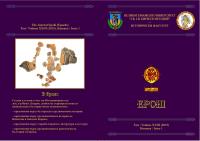Новите археологически проучвания на ранновизантийската и средновековна крепост Туида в Сливен – един провален проект
The latest research of the early Byzantine and medieval fortress of Tuida in Sliven – a ruined project
Author(s): Boris D. BorisovSubject(s): History, Archaeology
Published by: Великотърновски университет „Св. св. Кирил и Методий”
Keywords: early Byzantine and medieval fortress; Tuida; Sliven; archaeological excavations; First Bulgarian Empire; Regional museum of history of Sliven
Summary/Abstract: In the end of 2013 I received a persistent invitation from the head of the Regional museum of history of Sliven N. Sirakov to conduct the archaeological excavations of the early Byzantine and medieval fortress of Tuida (Tsoida) in the area known as “Hisarluka”. I was surprised and flattered because I am familiar with the history of the site from the very beginning of its first dig, when the team led by Irina Shtereva excavated it. Furthermore, 3 universities weregoing to take part in the new study – “St. Cyril and St. Methodius” University of Veliko Turnovo (Bulgaria), “Grigorii Tsamblak” University of Taraclia (Moldova) and “Bogdan Hmelnitski” University of Melitopol (Ukraine). The project seemed very promising and I decided to accept the proposal. Unfortunately soon the head of the museum of Sliven gaveup the initiative and tried to ruin it in every possible way.However, as a result of the excavations we managed to give a more precise dating of the first construction period. Due to the many unearthed coins, it was concluded that the fortress didn’t stop functioning during the invasion of the huns in 441 or in 447 as was previously thought, but it did in the beginning of the second half of the V century, probably during the invasion of the osthrogots. The numerous coins of Leo I (457 – 473) are a direct evidence of this.The early Byzantine and medieval stratigraphy and chronology of the fortress were fixed. The two reconstructional periods of the fortress which date back to the IX and XI century were registered. The overall stratigraphy of the site was cleared. Two partly preserved floor levels of medieval dwellings were found. The first dates back to the period of the Byzantine domination over the Bulgarian lands (XI – XII). The second onewhich has two periods of construction is from the reign of the First Bulgarian Empire. Right beneath them begins the layerwith the ruins of the early Byzantine structures.
Journal: Епохи
- Issue Year: 23/2015
- Issue No: 1
- Page Range: 19-29
- Page Count: 11
- Language: Bulgarian

